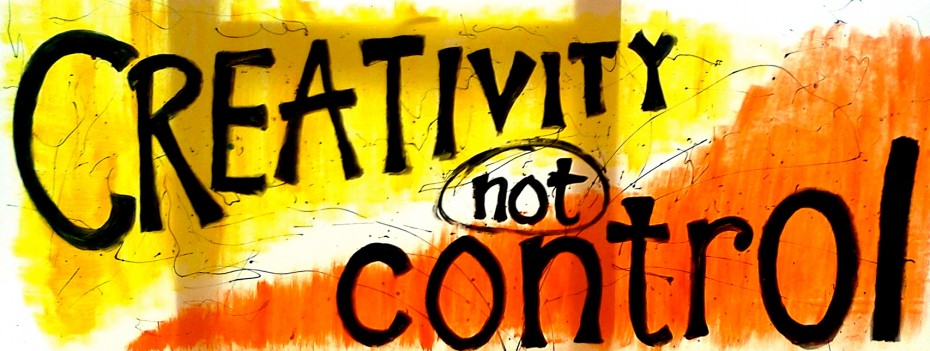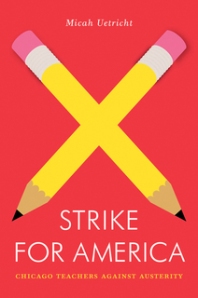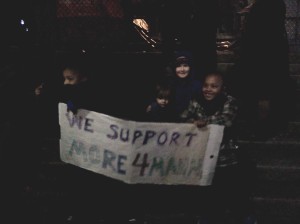Recently I’ve been wrestling with a question many teachers face: what should we do when our students’ learning journeys roam out of our carefully constructed lesson plans? We call these moments tangents, but what if they are actually creative lines of flight?
My formal teacher training didn’t prepare me to answer this question; the only solution I was taught was to suppress these tangents in order to make sure students meet my learning objectives. I’m experimenting with new approaches now, based on my students’ interventions in the classroom, the philosophical work of Deleuze and Guattari, and the dynamics of hip hop production.
My teaching masters program was useful as far as masters’ programs go; my professors were certainly supportive of my efforts to teach critical literacy, ethnic studies, and open-ended discussion to youth who are considered “at risk” by official society. They gave us plenty of intellectual ammunition to hurl back at the corporate eduction reformers who want to control and standardize learning at the expense of teachers, my students, and youth from similar socioeconomic backgrounds.
However, my professors’ hostility to standardization operated at the level of society, not at the level of the classroom. They taught us to advocate for our right to create our own lesson plans, free from the proto-totalitarian influences of Bill Gates, Eli Broad, and the other billionaires who want to recreate education in the image of their machinery. But they emphasized that our lessons themselves must be tightly planned. If they had any political program, it might be summed up as “all power to the teachers, the professionals who know how to craft effective plans, tailored to their specific situations.”
I’ve partially bought into this, out a desire for my own labor to be creative and well done. I also see its usefulness in terms of challenging the informal social hierarchies that permeate every classroom. For example, teachers need to intentionally plan to check our own biases. We need to intentionally organize our classroom layout and our activities so that students talk to each other, instead of simply talking to us, the people they’ve been trained to treat as authorities. And of course, we need to plan to differentiate the curriculum, so that students with disabilities are not left behind.
All of this certainly can advance beyond the banking model of education, where the teacher deposits knowledge in the students’ brains, which they then regurgitate on the test. But it still assumes that the teacher is the one who should set the pace, rhythm, direction, and content of the democratic discussions that our lesson plans are supposed to foster.
Teachers divide learning activities into discrete bundles, which we call learning objectives. We choose these objectives so each assignment builds on the previous one, in chains of increasing cognitive complexity, beginning with understanding facts and moving through application and analysis toward independent production of original work. My best lessons are tightly organized in these ways, and my students certainly build up confidence and motivation when they meet the initial objectives.
However, sometimes they use that confidence in ways that surprise me, and that diverge from the learning objectives I had in store for them further down the road. In many ways, these moments remind me of social movements I’ve been a part of, where crowds in motion suddenly change the political terrain, making our well-crafted strategies obsolete overnight.
Similarly, my students’ thinking becomes nomadic, roaming right out of the lessons I’ve mapped out for them. They open up entirely new lines of flight that lead into uncharted and possibly dangerous intellectual and emotional territories. For example, we are talking about religion’s role in society and suddenly a student shouts out “I’m gay, does that mean I won’t go to heaven?”, or we’re talking about some contemporary political debate and suddenly three students demand to know why the economy crashed and a fourth wants to figure out whether it has something to do with the Illuminati and a fifth makes a speech against conspiracy theories, prompting a debate that engulfs the class for the rest of the period.
I’m not talking about the moments where bored students tactically lay out a piece of tangent-bait hoping the teacher will get derailed so they don’t have to do their classwork. Usually those tangents are even more predictably scripted than our lessons. I’m talking about moments where students go on tangents precisely because they are NOT bored. Moments where the planned learning activities open up a vortex of emotion and thought because they touch on concepts, issues, and experiences that students usually do not get a chance to discuss in their daily lives. Something one student says resonates with the others, and it unfolds a waterfall of thoughts that students didn’t know they urgently needed to talk about until that moment. Now they are not going to want to talk about anything else – except for everything else that relates.
No matter what the teacher does, these new thought-machines have taken flight and are forming brainstorms of connections with each other, unfolding into wider and deeper layers of complexity at a pace the teacher can’t keep up with. The thinking we are doing together has become bigger than the teacher, and bigger than the students, and it demands space to form more and more connections.
Recently I’ve been reading the works of the philosophers Deleuze and Guattari, who shed some light on these moments. They argue that the universe is composed of pure difference constantly folding and unfolding itself into new identities. The forms and identities that exist at any given moment are real, but they are not the only way the world might have ended up, and they are constantly changing themselves into something else. New possibilities are always opening up, as people and things leak out of our identities in all directions. We open up lines of flight that break from the paths society has charted out for us, becoming nomadic, creating new lives.
This process does not fit neatly within the borders of the individual person. It leaks out of our minds, bodies, and identities. It happens within the individual, and among individuals as we interact, overlapping with our selves. Lines of flight are like desires, but we are not talking about “my” desires, or yours. We are talking about creation that seems to take a hold of me, you, and others, unleashing life we didn’t’ know we had in us.
In this sense, learning is not about discovering perfect truths that represent a stable reality composed of separate people and objects. That kind of learning leads to understanding , posing objectives like “students will identify what these things are, and show this on a test”. It objectifies things, and thus it objectifies knowledge. Instead of seeking understanding, Deleuze and Guattari argue that the really interesting pursuit is learning to think – which often involves learning to feel. Thought does not simply discover things, it creates new lines of flight. It creates concepts and desires that traverse our bodies and minds, weaving among each other and the people, machines, plants, animals, cities, economies, words, and music we interact with.
This is the kind of learning that my students seem most excited about, and when it erupts in the classroom, I’m reminded of why I love teaching/ learning. It is not simply about planning for social change; it is a movement with its own velocity and rhythm. Teaching/learning is about creating new concepts together with our students, going on nomadic journeys together in ways that undermine and cross society’s borders. Learning this way is always potential anarchy.
As Dave Cormier puts it,
I want my students to know more than me at the end of my course. I want them to make connections i would never make. I want them to be prepared to change. I think having a set curriculum of things people are supposed to know encourages passivity. I don’t want that. We should not be preparing people for factories. I teach to try and organize people’s learning journeys… to create a context for them to learn in.
To borrow Deleuze and Guattari’s metaphor, learning is less like a tree, and more like a rhizome. Learning like a tree implies hierarchy – you start with the roots, the base of knowledge, then you build upward in a predetermined trunk of application and analysis, and only then can you branch out and create fruits of your learning. This is similar to how I was taught to structure my learning objectives in graduate school – each lesson must build off the previous one in a planned way.
In contrast, a rhizome is a root structure with no clear beginning and end, no up or down. It can expand itself in multiple directions by creating networks, intertwining with soil, tress, and other rhizomes, and for this reason it is both innovative and resilient. It is organized, but not in a centralized or standardized way. It self-organizes, just like my students do when they push a class discussion into fruitful tangents.
This process reminds me of hip hop, which is no surprise considering that my students are both producers and consumers of hip hop’s cutting edges. Hip hop, at it’s best, does not follow a formula. It does not build on previous cultural genres in a linear way. Instead, it pulls little pieces of previous songs together into new networks of beats and samples. Then it pulls pieces of experience together into networks of rhymes that refer to each other and to life in exploratory, playful ways.
A Hip hop freestyle “reads” or interprets the current moment, writing its interpretations into new concepts immediately (without the mediation of approved intellectual categories). Concepts, images, sounds, senses, and experiences relate to each other in ways that don’t try to capture reality; instead, they sample and play (with) it.
For example, the emotional resonance of a certain beat combines with the stress a rapper puts on a specific word which evokes new ways that word is being spoken in particular cities that are going through their particular crises, resistances, and renaissances. Hip hop is learning, combining culture, current events, politics, and many other discourses and structures. But it connects things together that didn’t have any obvious connection before hip hop spun and palpated them into networks of sound and color. Hip hop is about growing rhizomes and nomadic journeys.
Unfortunately, students who immerse themselves in these journeys are then inserted into tidy boxes called classrooms, where they are expected to take their headphones off so they can consume and produce knowledge using methods originally designed to train workers for factory assembly lines.
No wonder they rebel. Many of the so-called disciplinary problems in classrooms might actually be a subterranean class struggle between nomadic rhizomes, and the structure that aims to chop them into pieces of identity so it can channel them into official trajectories of career, family, conformity, citizenship, gender, and race. Schools are the explosive meeting places where students’ rhizomatic journeys crack the system’s concrete, and roses grow through the cracks, as Tupac famously narrated.
So maybe teachers should organize classrooms in ways that participate in this rhizomatic learning instead of choking it with linearly planned lessons modeled after tree trunks and assembly lines. Maybe we should create learning environments where students can sample and reorganize thoughts in new ways, like many of them do when they produce hip hop. Maybe we should let our classroom discussions become freestyle cyphers, where students can immediately interpret each other’s thoughts into new lines of flight.
I’m still exploring how to do this. But one thing I’ve started to do is to make freestyle creation of concepts the learning objective of the lesson itself. That way, tangents become the point, and the whole class becomes a set of tangents, like the roots of a rhizome. I plan out lessons to share what skills students need to know in order to prepare for this, so that no one is left out (e.g. I teach them how to do an internet news search, or how to check for bias in a source). But then I let them think in multiple directions, allowing the objectives and the curriculum to emerge out of the process.
For example, we’ve recently been doing freestyle research cypher sessions. Students sit in a circle and each gets a copy of a Freestyle Research Worksheet and a laptop***. The teacher writes a few topics on the board, choosing from a survey of student interests conducted earlier. Everyone starts by researching one of those topics online, finding articles, images, and video related to it, and filling out their worksheets with this information. Whenever they find something interesting, they share it with the whole class, and the teacher projects it on the overhead projector and asks students what they see/ hear and what they think about it. These discussions then encourage other groupings of students to research topics related to what was discovered. Eventually different groupings emerge based on what students are interested in pursuing further, as they wander into related topics or concepts. At the end, we have an open discussion about what we’ve learned, and students write reflections integrating their new ideas together, drawing connections between the different topics.
I recognize there is a danger that students might simply touch on topics superficially, especially when there is not enough time to explore each of their interests in enough depth. It is important to keep track of issues or topics that might need further elaboration and to come back to them, possibly using these cyphers as jumping off points to construct more traditional lesson plans with scaffolded objectives. This could help students develop the background knowledge necessary to analyze particularly difficult issues that come up and could make future freestyle research discussions more fruitful.
In any case, this is an experiment, not a perfect answer to the question I posed at the beginning of this post. I am curious how other teachers and learners might answer this question in different ways. That’s why I’m throwing this post out into the blogosphere – which, of course, is its own rhizomatic learning process.
* The worksheet has multiple cells in google doc form, which students can fill out electronically and can share with the teacher and each other so they could collaborate on filling it out together if they want. This also makes it easier to project their findings onto an overhead screen.
**We are luckily enough to have laptops that work, which is not guaranteed in this era of austerity. It could also be done with archives of newspaper clippings, photos, artifacts, etc. I’ve also allowed students to use their smartphones, which lessens the conflicts students and teachers are always having about whether they should be allowed to use their phones in class.
Tags: class discussion, Corporate Ed "Reform", criticisms of school, cypher, Deleuze, Deleuze and Guattari, education, freestyle, Guattari, Hip Hop, laptops, Learning, Learning objectives, Lesson Plan, Lines of Flight, Pedagogy, Philosophy, research, Rhizomatic, Rhizomes, social studies teacher, Tangents, Teacher training, worksheet












What if we renamed ADHD “cognitive nomadism”?
20 OctI recently read an interesting article on ADHD which suggested that the genes that cause it are a legacy of nomadic ancestors:
I am skeptical about this, given the long history of empires attempting to dominate nomadic peoples, and the roles of education and medicine in this domination. Will this research be used to further stigmatize and pathologize the descendants of nomads who have migrated to the US because their peoples and cultures were destroyed by U.S.-backed wars?
US Empire claims to be orderly, organized, and efficient. It encodes these characteristics as normal, able-bodied, white, sane, male, straight, professional, and healthy. People of color, queer people, gender non-conforming people, indigenous people, and people with disabilities are coded as the opposite of these traits. The system deems them a problem that must be contained like an Ebola epidemic so that they don’t contaminate the body politic.
When schools suggest students with ADHD should be medicated and taught to conform, are they helping students navigate daily life in the empire, or are they playing into this system of control, cutting off potential creativity and rebellion?
I’m wondering what the philosophers Deleuze and Guattari would say about ADHD. They are strong advocates of nomadic ways of thinking and living, and argue that nomadic practices are part of contemporary struggles for freedom. They claim nomadic tendencies exist not only among indigenous peoples but also in the heart of empires, destabilizing them. They say that all human beings have a tendency to deterritorialize, to roam outside of the settled concepts, routines, traditions, and institutions that shape us; they argue this is a crucial part of creative cultural production. Their work has been extended by decolonial, Marxist, queer, and anarchist theorists who aim to destabilize borders, empires, and fixed / frozen social identities. It has also been extended by people who see migration and the creation of diasporas as potential ways to break down and move beyond the constraints of capitalist nation states.
To be clear, I’m not trying to romanticize nomadic life, ADHD, or migration. All of these involve real struggles and real human longings for consistency, commitment, community, and self-organization. Deleuze and Guattari also recognized this when they said that every deterritorialization is also potential reterritorialization. I also don’t mean to deny the practical strategies people with ADHD use to survive day to day life in our society, or the importance of giving youth chances to learn these strategies.
I’m just saying that those genes that express traits labeled ADHD are not vestiges of savagery that must be remolded in the name of progress. They are important expressions of human biodiversity and neurodiversity that could help create new futures. Saying they are not adaptive to modern desk jobs implies that cubicles represent the end of history, humanity’s final resting place. What if nomadic impulses might help us all collectively wander and fight our way to something better? What if they are remnants of courage and curiosity that enable a future exodus from our overstressed, boring society?
The postmodern liberal arts education I received at a particularly progressive Ivy League university gave me the privilege to explore, to roam through concepts, genres, and discourses at will. There were a lot of things about this school that also tried to force me into alienation, despair, careerism, and anxiety. But I did get to spend four years reading what I wanted to and staying up late in the dorms discussing it. If I said something off topic or showed up late it was seen as a mark of an eccentric intellectual, not a problem to be controlled.
Most working class students of color have none of these privileges. They are expected to learn what the system tells them to learn and if they get bored or restless they are punished and stigmatized as defective.
Given that, I wonder: is there a connection between schools’ attempts to keep students on task and the state’s attempts to police and limit the movement of human bodies, especially bodies it encodes as black and brown? Should we be teaching students with ADHD to adapt to the routines of the capitalist empire, or should we be adapting the ways we learn so that youth can unleash their positive forces of deterritorialization? Maybe they’ll end up creating social movements that transform reality and free all of us from cubicles.
——————>>>
I explored some ways to embrace cognitive nomadism in a previous blog post, Freestyle Learning in the Rhizomatic Cypher. This includes suggestions for how to organize learning activities that build on the power of curious tangents, rather than attempting to herd students into fenced-off fields of study.
Tags: ADHD, Deleuze, Guttari, Nomadism